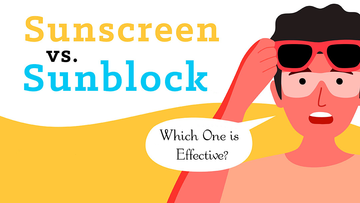What is Sunscreen?
Purpose of Sunscreen
Sunscreen serves as a vital protective barrier against the harmful ultraviolet (UV) rays emitted by the sun. Its primary purpose is to prevent the skin from absorbing or being damaged by these rays.
History of Sunscreen
The concept of sun protection can be traced back through centuries, with ancient civilizations using various natural substances. Modern sunscreen formulations, however, began to emerge in the early 20th century, evolving into the diverse range we have today.
Types of Sunscreen
Sunscreen comes in two main types: physical and chemical. Physical sunscreens use minerals like zinc oxide or titanium dioxide to create a barrier on the skin, reflecting and scattering UV rays. Chemical sunscreens, on the other hand, contain organic compounds like avobenzone or oxybenzone that absorb and dissipate UV radiation.
Ingredients in Sunscreen
Common sunscreen ingredients include UV filters, which block or absorb UV rays, emollients for smooth application, and preservatives to maintain product stability. Understanding these components helps users make informed choices based on their skin type and preferences.
Recommended SPF Levels
Sun Protection Factor (SPF) is a measure of a sunscreen's effectiveness in blocking UVB rays. The recommended SPF level depends on factors such as skin type, the duration of sun exposure, and the activities involved.
Benefits of Wearing Sunscreen
Protection from UV Rays
Sunscreen acts as a shield, providing comprehensive protection against both UVA and UVB rays, preventing skin damage and reducing the risk of skin cancers.
Prevents Sunburn
One of the immediate benefits of regular sunscreen use is the prevention of sunburn, a visible sign of skin damage caused by excessive UV exposure.
Reduces Risk of Skin Cancer
Consistent use of sunscreen is associated with a decreased risk of developing skin cancers, including the potentially deadly melanoma.
Prevents Premature Aging
Sunscreen helps maintain the skin's elasticity, reducing the likelihood of premature aging signs such as wrinkles and fine lines.
Helps Maintain an Even Skin Tone
By protecting against UV-induced hyperpigmentation, sunscreen contributes to maintaining a more even and balanced skin tone.
How to Choose the Right Sunscreen
Skin Type Considerations
Different skin types require specific formulations. Individuals with oily, sensitive, dry, or acne-prone skin should choose sunscreens tailored to their specific needs.
SPF Levels for Different Activities
The appropriate SPF level varies based on the duration and intensity of sun exposure during different activities. Higher SPFs are advisable for extended outdoor activities.
Different Forms of Sunscreen
Sunscreen is available in various forms, including sprays, lotions, and sticks, each catering to individual preferences and convenience.
Water and Sweat Resistant Options
Water-resistant and sweat-resistant sunscreens are essential for activities involving water or perspiration to ensure prolonged protection.
Choosing a Sunscreen for Children
Children's skin is more delicate and prone to irritation. It's crucial to use specially formulated sunscreens with gentle ingredients suitable for their skin.
Proper Application Techniques for Sunscreen
How Much Sunscreen to Apply
Applying an adequate amount is crucial for effective protection. A nickel-sized dollop for the face and a shot glass full for the entire body are general guidelines.
Ideal Time to Apply Sunscreen
To maximize absorption and protection, apply sunscreen 15-30 minutes before sun exposure.
Areas of the Body to Focus On
Ensure complete coverage, paying attention to often neglected areas like the ears, back of the neck, and tops of the feet.
Sunscreen and Makeup Application
Sunscreen should be applied before makeup. Some makeup products contain SPF, but relying solely on them may not provide sufficient protection.
Reapplying Sunscreen Throughout the Day
Reapplication every two hours, or more frequently if swimming or sweating, ensures continuous protection, especially during prolonged sun exposure.
Sunscreen for Different Skin Types
Best Sunscreen for Oily Skin
Choose oil-free and non-comedogenic sunscreens to avoid clogging pores and causing breakouts.
Best Sunscreen for Sensitive Skin
Opt for fragrance-free and hypoallergenic sunscreens designed for individuals with sensitive skin.
Best Sunscreen for Dry Skin
Cream or lotion-based sunscreens with added moisturizing components are ideal for those with dry skin.
Best Sunscreen for Acne-Prone Skin
Non-comedogenic sunscreens won't exacerbate acne, and some formulations may even help control breakouts.
Best Sunscreen for Aging Skin
Sunscreens with added antioxidants provide extra protection against the aging effects caused by free radicals.
DIY Natural Sunscreen Options
Ingredients to Look for in Homemade Sunscreen
Zinc oxide and titanium dioxide are common minerals used in DIY sunscreens. Individuals can choose ingredients based on personal preferences and skin sensitivities.
Recipes for Homemade Sunscreen
Creating homemade sunscreen involves combining desired minerals with carrier oils. Precise recipes ensure effectiveness and safety.
Pros and Cons of Homemade Sunscreen
While homemade sunscreen provides a natural alternative, it may lack stability and precise SPF levels. Commercial options undergo rigorous testing for safety and efficacy.
Tips for Using Homemade Sunscreen Effectively
Ensure even application, reapply as needed, and monitor the skin for any adverse reactions. Homemade sunscreen may require more meticulous attention to achieve optimal results.
Precautions to Take When Using Homemade Sunscreen
Exercise caution, perform a patch test before widespread use, and be aware that homemade sunscreen may not provide the same level of protection as commercially available options.
Common Misconceptions About Sunscreen
Sunscreen and Vitamin D Production
While sunscreen may reduce vitamin D synthesis, it's essential to balance sun exposure for adequate production. Short periods without sunscreen can contribute to sufficient vitamin D levels.
Sunscreen and Tanning
Tanning is a sign of skin damage, and sunscreen helps prevent this damage. Sunless tanning options provide safer alternatives.
Sunscreen and Skin Color
Regardless of skin tone, everyone benefits from sunscreen. While darker skin offers some natural protection, it does not eliminate the risk of UV damage.
Sunscreen and Waterproof Activities
Water-resistant sunscreens are designed for water activities, but reapplication is crucial for continued protection, especially after prolonged water exposure.
Sunscreen and Expiration Dates
Expired sunscreen may lose effectiveness. It's important to check expiration dates and store sunscreen properly to ensure its potency.
Sunscreen and Athletic Activities
Importance of Sunscreen for Outdoor Sports and Activities
Athletes engaged in outdoor sports benefit significantly from sunscreen, protecting them from prolonged sun exposure.
Guidelines for Choosing the Right Sunscreen for Sports
Consider water and sweat-resistant formulations with higher SPF for extended outdoor activities, ensuring effective protection during physical exertion.
Benefits of Sweat and Water Resistant Sunscreen for Athletes
Sweat and water-resistant sunscreens are designed to withstand the rigors of physical activity, providing prolonged protection even in challenging conditions.
Tips for Reapplying Sunscreen During Activities
Plan breaks to reapply sunscreen, especially during extended periods of intense physical activity, to maintain consistent protection.
Precautions for Using Sunscreen While Playing Sports in Extreme Conditions
In extreme conditions, such as high altitudes or intense heat, take extra precautions. In addition to sunscreen, consider wearing protective clothing and staying hydrated.
The Role of Sunscreen in Skincare Routines
Sunscreen and Anti-Aging Products
Combining sunscreen with anti-aging products enhances skin protection, preventing further damage caused by UV radiation.
Sunscreen and Acne Treatment
Non-comedogenic sunscreens won't exacerbate acne, allowing individuals to maintain their acne treatment regimens without compromising skin health.
Sunscreen and Evening Out Skin Tone
Regular use of sunscreen helps prevent hyperpigmentation, contributing to a more even and balanced skin tone over time.
Benefits of Daily Sunscreen Use
Consistent daily use of sunscreen provides continuous protection against UV damage, maintaining overall skin health and preventing long-term damage.
How to Incorporate Sunscreen into Your Skincare Routine
Apply sunscreen as the final step in your skincare routine, before makeup if applicable, to ensure maximum efficacy and protection throughout the day.
Sunscreen Safety and Side Effects
Possible Side Effects of Sunscreen
Some individuals may experience mild skin reactions, such as redness or irritation, especially if they have sensitive skin. Switching to a different formulation or brand can often resolve these issues.
How to Test for Sunscreen Allergies
Performing a patch test with a small amount of sunscreen on a small area can help identify potential allergies before widespread use.
Safety Concerns with Certain Sunscreen Ingredients
Stay informed about the safety of sunscreen components, as some chemical ingredients may raise concerns. Continuous monitoring of regulatory updates is advisable.
Tips for Safely Using Sunscreen on Children
Use specially formulated sunscreens for children, avoiding those with harsh chemicals. Additionally, encourage other sun-protective measures like hats and clothing for comprehensive protection.
Alternatives to Traditional Sunscreen for Sensitive Individuals
Physical blockers like zinc oxide and titanium dioxide are gentle alternatives for those with sensitivities to chemical filters. These alternatives provide effective sun protection without compromising skin health.
Environmental Impact of Sunscreen
Chemicals and Coral Reefs
Certain sunscreen chemicals, such as oxybenzone and octinoxate, have been linked to coral bleaching and damage to marine ecosystems. Opt for reef-friendly options to minimize environmental impact.
Eco-Friendly Sunscreen Alternatives
Choose sunscreens with mineral filters like zinc oxide or titanium dioxide, as they are generally considered more environmentally friendly.
Packaging Sustainability
Consider sunscreens with eco-friendly packaging, such as recyclable or biodegradable materials, to reduce environmental waste and promote sustainability.
Sunscreen and Medical Considerations
Sunscreen and Medication Interactions
Some medications, like certain antibiotics and acne treatments, can increase sensitivity to sunlight. Consulting with a healthcare professional is crucial to ensure the compatibility of sunscreen with any medications.
Sunscreen during Pregnancy
Sunscreen is generally considered safe during pregnancy. However, pregnant individuals should consult with their healthcare providers to address any specific concerns and ensure the well-being of both mother and baby.
Sunscreen and Global Skin Health
Skin Cancer Awareness and Prevention
Promoting awareness of the importance of sunscreen in preventing skin cancer is crucial for global skin health. Community education programs and public awareness campaigns play a vital role in this regard.
Sun Protection Campaigns
Participating in or supporting public awareness campaigns about sun protection helps educate communities about the risks of UV exposure and the benefits of regular sunscreen use. Collaborative efforts contribute to a global commitment to skin health.
Emerging Trends in Sunscreen Technology
Nanotechnology in Sunscreen
Advances in nanotechnology have led to the development of nanoscale particles in sunscreen formulations, offering improved transparency and coverage. Stay informed about evolving technologies for enhanced sun protection.
Innovations in Application Methods
Continuous spray, powder, and other innovative application methods are emerging in the sunscreen industry, providing additional options for users. Exploring and adopting these innovations can enhance user experience and adherence to sun protection practices.






